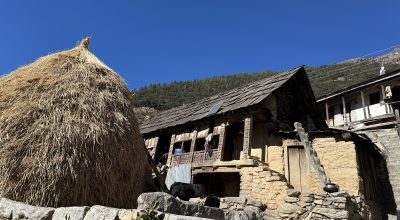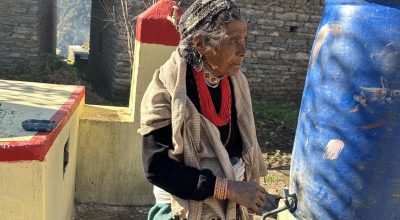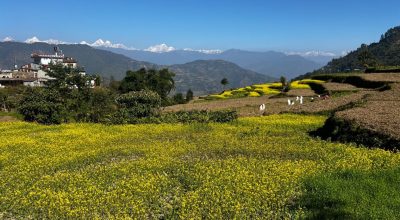
Kathmandu can restore some of its lost greenery with vertical gardens
Kathmandu, Aug 30, 2019: Kathmandu was described by early expats as an ‘emerald valley’. During the monsoon, terrace paddy fields and forested hills carpeted the basin in verdant shades of green.
Today, there is barely any green spaces left. But in a small way, Spanish artist Iñigo Iriarte is out to change that. ‘Indi’, as the Pamplona native likes to be called (in photo below), paints walls with a palette of living plants.
His geotextile canvas is a moist fabric wall alive with leaves and roots, flowers and fruits, water, air and colonies of tiny living creatures. The vertical gardens are living art with broad strokes of a variety of green and tufts of vivid moss, daubs of purple, orange or white where flowers have bloomed.

Vanishing land, Taylor Mason
Iriarte borrows heavily from expressionist tendencies when he paints on stretched canvas. Similarly, these living compositions speak of the artist’s dual love for the city and nature, but also of how they struggle to coexist.
Iriarte moved to Kathmandu two years ago with his wife and found reasons and an opportunity here to venture beyond his indoor paint-and-canvas studio into open space. It all started after he was invited to not just paint the inside wall of a spa at Shaligram Hotel, but also cover a blank white wall in the courtyard with a vertical garden.
The result was a stunning green wall stretching across a dhara spout and basin like an oasis. A sudden calming presence, perfect preparation for a spa client to experience a restful treatment to come.
Kathmandu’s latitude is subtropical, but its altitude lends a distinctive climate, rich with summer rain and cooled with dry winters. There is enough moisture and warmth for plants to thrive, so a cityscape of blank walls and hard surfaces could easily be regreened by vertical gardens.
Iñigo Iriarte is inspired by French botanist Patrick Blanc, a pioneer of vertical gardens, but takes an ecosystem approach to his selection of plants. Many vertical gardens fail because they are ornamental and used for a wow effect, with little regard for how individual plants like to grow.
Iriarte optimises nature’s own tendencies to create resilient ecosystems and microclimates that regulate themselves. He selects plants and places them according to natural growth patterns: those that prefer drier root biomes are higher, where there may be less water. Plants that thrive in wetter conditions are placed lower on the wall.
He does not pander to those who just want a green wall — he will leave space free for moss and other unidentified free loaders to take residence on nutrient-rich walls. Sometimes, parasitic plants hitch a ride on their nursery hosts and take root alongside them, becoming part of the family. Occasionally, plants fail and need to be replaced.
One of Iriarte’s sites, at the rooftop Rain Restaurant in Jawalakhel, is alive with over 25 varieties, from orchids to monstera, ferns to succulents, bromeliads to bamboo and surprisingly — on a wall of matted fibre and root substrates of crumpled fabric — fruiting citrus plants. There is also rosemary, happily sticking to its sunny spot on the south facing wall. “Plant health and happiness, and their ensuing resilience, is key,” explains Iriarte.
Something fishy in new Nepal farm, Hrijata Dahal

The wall at Rain is based on aquaponics and recycles water from a fish tank below the plants to the microbially dense geotextile wall. The wall acts as a biofilter to convert water rich in ammonia from fish waste into water rich with nitrates and other nutrients that the plants can absorb, thus making it clean and safe enough to be returned to the fish tank in a water cycle.
Rain’s bartender Tara Adhikari plucks sprigs of rosemary or fruits from the tiny lime tree for some of his classy cocktails, saying: “We make good cocktails because of the freshness of the ingredients we use, some of which come from Indi’s wall. A vertical garden is a new concept in Nepal, and we took a risk, but the guests like it.”
Every installation is different, tailored to its context, taking into account aspect, exposure to the elements and purpose. For the three walls Iriarte has installed in Kathmandu, including a testing bed at home, all the hardware and plants are locally sourced.
“It would be great to see plants of the surrounding mountains here to green the city using the least space possible and with maximum effect in cleaning the air and creating calm living environments for people and other living creatures,” says Iriarte.
Not many other countries can boast a landscape as three-dimensional and vertical as Nepal, and it is fitting that even as Kathmandu is built up, vertical walls can help it reclaim some greenery and bring back plants, birds, insects and microbes to coexist with humans.
(Source: Nepali Times, https://www.nepalitimes.com/here-now/garden-walls )
















